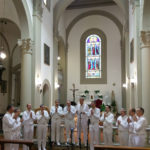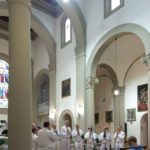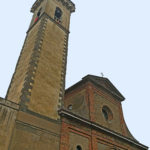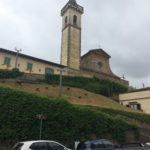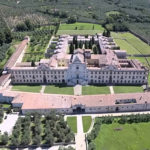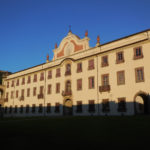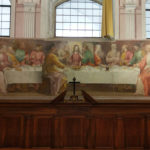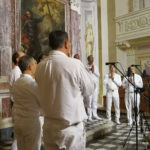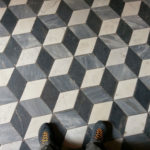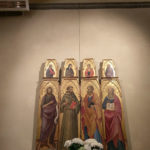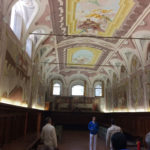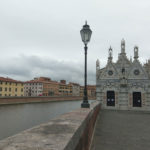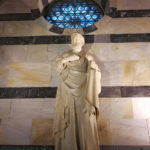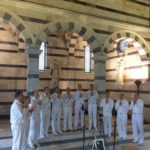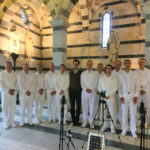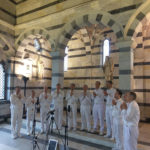Thursday 27 April
1) A leisurely morning drive brought us at 10.30pm to a picturesque town and to the Church of Santa Croce in Vinci, where on 16 April 1452, the town’s most famous son was baptised. Originally from the 13th century, the church has since been rebuilt several times though the stone font in which Leonardo da Vinci was baptised still stands. Oneness-Dream had the church to ourselves and found the acoustic very much to our liking. Being in a quiet area and with no pressing time constraints, the choir decided to forego a visit to the nearby Leonardo da Vinci Museum in favour of an extended recording session. With no audience, we were able to sing songs several times over and work on achieving a satisfying performance. Sadly, the recordings of this session are lost, though the audio of a few video tracks remain to give a hint of these few “lost” hours.
2) After lunch our next appointment at 3pm was at the massive and imposing “Certosa Monumentale di Calci” set in “Val Graziosa” among the rolling hills of the Pisan Mountains. This former Carthusian Monastery, established in 1366, is testimony to the importance, prestige and wealth of the religious orders in earlier times. Several of the numerous buildings now house the University of Pisa’s Natural History Museum. Most of the innumerable artworks and decorative features both outside and inside date from the 17th and 18th centuries. The choir were scheduled to sing in an ornate former refectory for the monks: our eyes and ears were drawn instead to a smaller “Chapter Room” adjacent to this eating hall, which boasts a sumptuous acoustic to match its ornate decoration. Sadly, the recordings of this session are also lost, though the audio of a few video tracks remain.
3) A short drive found Oneness-Dream in the historic city of Pisa on a quiet, damp evening. At 6.30pm our final recital for the day was in the small Church of Santa Maria della Spina, uniquely situated on the River Arno, seemingly squeezed between the river and a busy road. The church, originally erected in 1230 though later restored a few times, is considered one of the finest extant examples of Gothic design in Europe. The name of della spina (“of the thorn”) is derived from the presence of a thorn reputedly from the crown of thorns placed on Christ’s head at the time of the crucifixion – though the thorn now resides in a museum elsewhere in the city. The church is administered by the City Council as a gallery for the display of artworks and installations. Our visit was hosted by the City’s minister for Culture, Mr Andrea Ferrante, who greeted the choir warmly. Sadly, both the audio and video recordings of this performance are lost.
